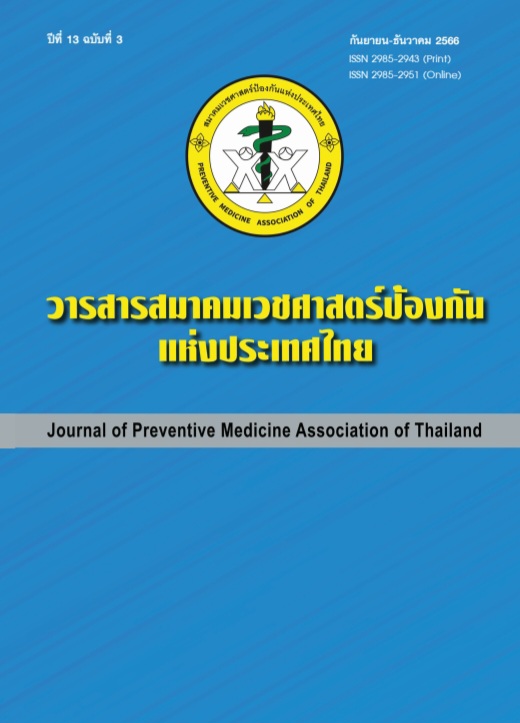The Result from Development of Medication Management System in Palliative Care Program in End Stage of Cancer Patients in Samphran Hospital, Nakhon Pathom Province
Keywords:
palliative care, end stage of cancer patient, Medication Management System, Drug Related Problems, DRPsAbstract
Objective: Descriptive prospective design, the purpose of this research was study the result from development of Medication Management System in Palliative Care Program in end stage of cancer patients in Samphran hospital. Methods: A sample of patients with inpatient end stage cancer in the palliative care ward was selected using purposive sampling of Palliative Performance scale was ≤50% included 54 cases. The data was conducted from 1st April 2023 to 31st August 2023. Results: The sample group was male 24 cases (44%) and female 30 cases (55%). We found that most of age between 60-69 years old. Most of the studied subjects were advance stage lung cancer 12 patients 22.22%. The initial symptoms that led to the treatment in palliative program were dyspnea & fatigue (Mdn=8, IQR=0-10), pain (Mdn=6, IQR=0-10). After receiving interventions from the palliative care program, the post-treatment follow-up revealed significantly decreased severity of all symptoms (p<0.05). Fourty-six patients (85.2%) were accessed to strong opioids. The drug related problems (DRPs) before medication Management System were found 54 cases (92 problems) respectively with the average 1.7 times per patient and DRPs after medication Management System were found 10 case (15 problems) respectively with the average 0.4 times per patient. The DRPs after medication Management System was significantly improved. Pharmacists’s recommendations were received 49 cases (90.7%) with all recommendation acceptance, 5 cases with partial acceptance and 0 case no recommendation acceptance. Conclusion: The results of this study was medication management system is important to treatment or care patients for efficacy and quality care and treatment outcome in hospital. The pharmacist’s role is continuous review of patient’s medications and ongoing contact with the interdisciplinary team. It is essential to minimizing medication-related problems and improving outcomes and efficacy. It is intended to improved quality of life of the end-stage of cancer patients and family.
References
สำนักงานปลัดกระทรวงสาธารณสุข. แนวทางการบริหารจัดการระบบยาในการดูแลผู้ป่วยแบบประคับประคอง (Palliative Care) ของหน่วยงานในสังกัดสำนักงานปลัดกระทรวงสาธารณสุข. นนทบุรี: สำนักงานปลัดกระทรวงสาธารณสุข; 2561. หน้า 4-6.
Pairojkul S, Thongkhamcharoen R, Raksasataya A, Nakawiro P, Sorasit C, Sudsa S, et al. Integration of specialist palliative care into tertiary hospitals: a multicenter point prevalence survey from Thailand. Palliat Med Rep 2021;2(1):272-9.
ฉัตราภรณ์ ชุ่มจิต, เยาวลักษณ์ อ่ำรำไพ. การจัดการระบบยาเพื่อความปลอดภัยด้านยาในโรงพยาบาล: บทวิเคราะห์ปัญหาและโอกาสในการพัฒนา. ไทยเภสัชศาสตร์และวิทยาการสุขภาพ 2552;4(1):127-35.
Herndon CM, Nee D, Atayee RS, Craig DS, Lehn J, Moore PS, et al. ASHP guidelines on the pharmacist’s role in palliative and hospice care. Am J of Health-System Pharm 2016:73(17):1351-67.
ดาริน จตุรภัทรพร. วิธีการประเมินความสามารถในการช่วยเหลือตัวเองของผู้ป่วยโดยใช้ Palliative Performance Scale (PPS) ภาควิชาเวชศาสตร์ครอบครัว [อินเทอร์เน็ต]. 2559 [เข้าถึงเมื่อ 20 มี.ค.2565]. เข้าถึงได้จาก: http://med.mahidol.ac.th/fammed/th/postgrad/doctorpalliative3th.
Chewaskulyong B, Sapinun L, Downing GM, Intaratat P, Lesperance M, Leautrakul S, et, al. Reliability and validity of the Thai translation (Thai PPS Adult Suandok) of the Palliative Performance Scale (PPSv2). Palliat Med 2012;26(8):1034-41.
Victoria Hospice Society. Palliative Performance Scale (PPSv2) version 2. Medical Care of the Dying 2006;4:121.
Chinda M, Jaturapatporn D, Kirshen AJ, Udomsubpayakul U. Reliability and validity of a Thai version of the edmonton symptom assessment scale (ESAS-Thai). J Pain Symptom Manage 2011;42(6):954-60.
สุลาวัณย์ วรรณโคตร. การพัฒนาระบบการดูแลแบบประคับประคอง ในผู้ป่วยมะเร็งระยะสุดท้าย: กรณีศึกษา โรงพยาบาลเขาวง. [วิทยานิพนธ์ปริญญาเภสัชศาสตรมหาบัณฑิต]. มหาสารคาม: มหาวิทยาลัยมหาสารคาม; 2561.
ศิริทัศน์ กระดานพล, ภานุพัฒน์ พุมพฤกษ์. ความคิดเห็นของเภสัชกรต่อความสามารถของตนเองในงานดูแลผู้ป่วยแบบประคอบประคองตามความคาดหวังของทีมสหสาขาวิชาชีพ. วารสารวิจัยระบบสาธารณสาธารณสุข 2560;11(1):91-101.
ภัทรานิษฐ์ เมธีพิศิษฐ์, อาภาพร วงษ์นามพรหม, น้ำอ้อย ภักดีวงษ์. ผลลัพธ์และกระบวนการดูแลแบบประคับประคองในผู้ป่วยมะเร็งลุกลาม. วารสารพยาบาลกรุงเทพ 2561;41(1):75-83.
สำนักนโยบายและยุทธศาสตร์ กระทรวงสาธารณสุข. แผนยุทธศาสตร์ระดับชาติว่าด้วยการสร้างเสริมสุขภาวะในระยะท้ายของชีวิต ปีงบประมาณ 2566: ร้อยละการบรรเทาอาการปวดและจัดการอาการต่าง ๆ ด้วย Opioid ในผู้ป่วยประคับประคองอย่างมีคุณภาพ [อินเทอร์เน็ต]. 2566 [เข้าถึงเมื่อ 2 ม.ค. 2566]. เข้าถึงได้จาก: http://healthkpi.moph.go.th/kpi2/kpi-list/view/?id=1602
ศุภชัย แพงคำไหล, พีร์ วัชรวงษ์ไพบูลย์. การพัฒนาแนวทางส่งเสริมการเข้าถึงยากลุ่มโอปิออยด์ (opioids) แบบสหวิชาชีพที่บ้านสำหรับการดูแลผู้ป่วยระยะสุดท้าย อำภอยางสีสุราช จังหวัดมหาสารคาม. วารสารวิชาการสาธารณสุข 2564;30(ฉบับเพิ่มเติม 1):S76-86.
ทิพย์สุคนธ์ เจริญพันธ์, จันทรรัตน์ สิทธิวรนันท์. การพัฒนาบทบาทเภสัชกรในทีมสหวิชาชีพสำหรับการจัดการอาการปวดด้วยยาในผู้ป่วยโรคมะเร็งระยะลุกลามอย่างต่อเนื่องจนถึงที่บ้าน โรงพยาบาลหนองเสือ จังหวัดปทุมธานี. ไทยไภษัชยนิพนธ์ 2565;17(2):1-21.
วราภรณ์ อุ่นจันทึก. การเปรียบเทียบผลลัพธ์ก่อนและหลังการให้บริบาลทางเภสัชกรรมผู้ป่วยประคับประคองในคลินิกประคับประคองผู้ป่วยนอก โรงพยาบาลสีคิ้ว จังหวัดนครราชสีมา. วารสารวิจัยและพัฒนาด้านสุขภาพ สำนักงานสาธารณสุขจังหวัดนครราชสีมา 2564;7(1):32-44.
สิญาภรณ์ วงศ์คร้าย, ขวัญจิต ด่านวิไล, ธีรพล ทิพย์พยอม. ผลของการบริบาลทางเภสัชกรรมต่อคุณภาพชีวิตของผู้ป่วยมะเร็งเต้านม : การทดลองแบบสมและสุ่มและมีกลุ่มควบคุม. วารสารเภสัชกรรมไทย 2561;11(4): 828–39.
Downloads
Published
How to Cite
Issue
Section
License
Copyright (c) 2023 Journal of Preventive Medicine Association of Thailand

This work is licensed under a Creative Commons Attribution-NonCommercial-NoDerivatives 4.0 International License.
บทความที่ลงพิมพ์ในวารสารเวชศาสตร์ป้องกันแห่งประเทศไทย ถือเป็นผลงานวิชาการ งานวิจัย วิเคราะห์ วิจารณ์ เป็นความเห็นส่วนตัวของผู้นิพนธ์ กองบรรณาธิการไม่จำเป็นต้องเห็นด้วยเสมอไปและผู้นิพนธ์จะต้องรับผิดชอบต่อบทความของตนเอง






